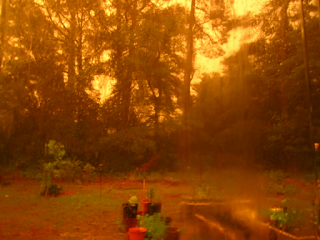Welcome back to another episode of Lost In The Farmers
Market. I have to open this post with a bit about weather safety. As you may
realize, the recent weather has brought us a lot of rain, but also with it
comes a bit of danger. As those of you who live in Fayetteville might have
noticed, the thunderstorms while excellent at providing much needed rain, are
also perfect conditions for high winds, potential tornadoes, flash floods and
or hail. There is also the risk of downed trees, and flying debris to consider.
In our last storm we received 1.6” of rain and the one before that 2” and the
mega storm two weeks ago 3”, this poses several problems. The fertilizer you
applied in your fields may have washed out, yet you’re getting a mega-dose of
atmospheric nitrogen. Likewise with all the water flowing through you may have
lost some topsoil. These storm cycles are excellent for certain crops such as
figs but terrible for more delicate fruits. In the end I advise that all of you
who read this remember to take caution during storms, the severe weather
advisories seen on TV and the Radio are no joke even if the weird sound effects
on the radio ones make them seem so.
With that in mind I did not attend the Saturday market this
week because of the weather, we had a line of ugly storms come through on Friday
evening and they persisted into the early morning hours of Saturday. Honestly, with
the high daytime temperatures and the thunderstorm activity, I think we can
officially call it Monsoon season. Despite this, as you know, we are in the middle
of transfer season, the spring veggies are nearing their end, but the summer
herbs, and perennials are just about to begin. I’ll keep a variety of peppers tomatoes
and a few other odds and ends available, but expect more of the fine summer
specials, and of course aloe vera plants in three sizes for your medicinal
enjoyment. The new plant list should be available and posted up here later in
the week. In the next post I’m going to
show you some tricks to help keep your garden irrigated in these difficult
weather conditions. For this week I finish this post with a photo or two.
 |
| Aloe barbadensis/vera – Medicinal Aloe |
This is ‘Big Mother’ the oldest aloe in the collection and
the largest potted house plant I own. I’ve had this plant for about five years,
and for most of that time it has been in an small 6” pot. The aloe plant was so
heavy that it used to top over its old pot so I had to put it in a large
thick-walled container made out of terra cotta and weigh it down with stones so
it would not tip over. Earlier this year ‘Big Mother’ was repotted finally to a
much larger 12” pot as seen in the picture. All the little aloes I’m selling
came from this one plant and as you can see, this aloe is now free of pups. Grown 100% organically, you will have a hard time
finding healthier plants.
 |
| Adenium obesum – Desert Rose |
The desert Rose is one of those plants that a plant enthusiast
seeks out for the reward of its blooms. Sort of like a Holiday cactus in use,
the Desert rose validates the effort to find one by blooming once a year with
stunning blooms that are pink, red or some shade in-between. A well cared for
Desert rose will bloom twice a year or in the case of mine twice a year and on
every stem. The blooms can be so heavy that the stems bend and desert roses can
get so large that they resemble a small shrub with corky bark. As for care, you
barely water or fertilize this succulent and treat it like a true tropical. This puts a cork in the bottle for this weeks post, check back for another post later detailing the current plant selection and DIY irrigation tricks.


















